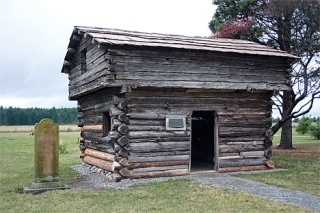Sunnyside Cemetery is a beautiful place, especially the fields. The soil can be black, gold or green depending on the season. I have a lot of relatives there — my parents, great-grandparents, aunts, uncles and cousins.”
So says Lillian Huffstettler, a member of “Daughters of the Pioneers” whose family migrated to Whidbey Island in 1850, about 15 years before the creation of “Ebey Grave Yard” and the start of a cemetery that would one day be named Sunnyside.
While Ebey’s Landing National Historic Reserve is famously unique for its living landscape, the hillside cemetery is a solemn oasis surrounded by active farmland. It serves as a burial ground for pioneers who crossed the Oregon Trail, sea captains who sailed into Penn Cove and decedents of Native Americans.
“My grandpa was paid about $25 a year to keep up the cemetery,” Roger Sherman, chairman of the cemetery district, recalled of his childhood. “As a kid, a lot of my spending money came from digging graves.”
For about 100 years, Sherman’s family has helped preserve Sunnyside, with both physical labor and oral history.
One of the ties to Whidbey Island’s early settlement period is the Davis Blockhouse, located to the north of the grave sites.
Settlers constructed 11 blockhouses in the 1850s in response to fears of the so-called “Northern Indians” from Canada and American Indians in the Puget Sound region.
“Families would often sleep in the blockhouses at night,” Sherman said. “But there was never any attack.”
Except, of course, for one famous attack involving the reserve’s namesake.
Along with the perceived danger of early tribes, Native Americans were segregated from the general population in Sunnyside, and buried along the western fence line.
Recently, the ramshackle blockhouse needed protection of its own from the elements, to “re-stabilize” it. A team from Colorado replaced several logs and embedded it with steal beams to help it last another 50 years.
Touring the rest of the graveyard, some of the earliest monuments are those of the Ebey family. Before Sunnyside was established, settlers cordoned off a small plot of ground on their claims to serve as burial space. In 1865, it was Mary Bozarth that sold a quarter acre of her family’s farm at $1 for the “County Grave Yard on the Hill.”
The first burial was Mary’s brother Winfield Scott Ebey, who was plagued by tuberculosis. In 1864, he attempted to cure himself by sailing to California for a warmer climate, but it was too late. According to sunnysidecemetery.org, his final letter to his sister read, “I should like to live longer but death must come upon us sooner or later. I have found but little in this world worth living for.”
Perhaps a more tragic story is that of Isaac Ebey, the first person to file for land on Whidbey. In August 1857, Isaac, 39, was killed by Indians.
The fate of his head is part of the island’s historical lore. Following Ebey’s murder, the raiders took the head with them. Isaac’s brother tried to convince Washington territorial officials to send a party to pursue the Native Americans and reclaim his brother’s head. But neither the Washington Territory or U.S. Army would take on the chore.
Three years after the murder, the scalp was finally retrieved by Captain Charles Dodd of the Hudson’s Bay Company, who purchased it at an Indian village. It was described as having “the skin of the head, the ears and most of the hair.”
While some histories say the scalp was buried immediately, other accounts and diary entries reported that it was passed from family member to family member, as a “sad memento” of Ebey’s death. Today, its whereabouts are unknown.
Incidentally, another well-known figure of Whidbey Island was the Indian’s original target, for the reparation of their leader’s death the previous November. But he was gone from the island at that time. Dr. John Kellog was referred to as the “Canoe Doctor” for his mode of travel to reach far-away patients.
In 1874, Kellog purchased two acres from Bozarth that adjoined the former Ebey Grave Yard on its western edge for the cemetery’s first expansion.
Near the end of the 1800s, bodies buried on family farmland were exhumed and reburied in the cemetery. Families were often diligent about caring for the grave sites. On Memorial Day weekend, the town would hold a potluck in Sunnyside and men would clean the lots while the women put up flowers.
But soon this ritual faded away and the cemetery became ill-kept. Billy Sherman was hired as the first caretaker in the 1920s, during the county’s “clean cemetery” campaign.
Roger Sherman noted that a few of the family sites are surrounded by steel fences because escaped farm animals would often wander into the cemetery.
“Some of the old families didn’t like having their plots tromped on. Other families said the fences kept their families together,” Sherman said.
Today, many of the markers of early settlers are missing or deteriorated, because families could only afford wooden boards. In the early 1900s, some markers were accidently burned by the Ladies of the Roundtable, who attempted to burn brush around Sunnyside.
Sherman recommends researching more of the histories before making a visit, especially the markings on the graves, many of which signify fraternity membership.
Huffstettler, who has always had an interest in family history, remembers that as a child she and her father used to clean moss off of her family’s headstones. Some of the monuments that mark Sunnyside Cemetery tell their own stories.
Coupeville families and others can recall their own histories by taking a tour, with the help of www.sunnysidecemetery.org, contact information and a location map.



